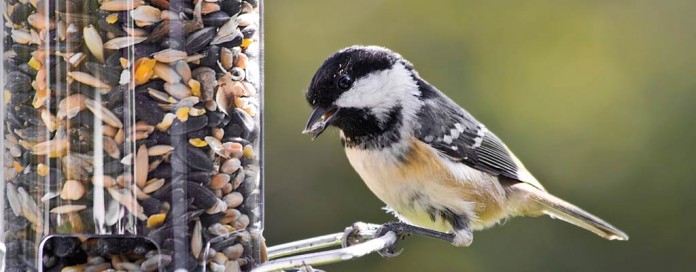After an unseasonably warm early November, winter birds have returned to my feeders. Last week white-throated sparrows and dark-eyed juncos arrived, and I’ve seen reports of pine siskins and purple finches from a variety of locations.
Put up a bird feeder this week, and you’ll soon see a nice variety of birds, including chickadees, titmice, goldfinches and cardinals.
Bird feeder
If you’re a first-time bird feeder, you probably wonder what foods to offer and what birds to expect. Sunflower seeds attract the greatest variety of feeder birds. Black-oil sunflower is appealing because of its rich oil content and its thin, easy-to-crack shells.
Virtually every seed-eating bird eats black-oil seeds. Striped sunflower seed shells are heavier and more difficult for smaller birds to crack. It’s a favorite of cardinals, grosbeaks, and blue jays.
Sunflower seeds
Hulled sunflower seeds are more expensive because the hulls have been mechanically removed. But there is no mess and no waste; every ounce of the kernels is eaten. Though sunflower kernels are a terrific food, they must be kept dry. Nyjer®, the tiny black seeds often erroneously called “thistle,” attracts goldfinches, siskins, house finches, redpolls, and purple finches.
Nyjer
Because Nyjer is imported from Africa and southeast Asia, it’s expensive, but its high oil content makes it great winter food.
Nuts
Nuts are another pricey bird food, but their appeal to popular birds such as chickadees, titmice, and woodpeckers justifies the expense. Peanuts, walnuts, pecans, and almonds are now often found it better quality bird food mixes. Stainless steel wire mesh tubes require birds to remove individual nuts so they disappear slowly from this type of feeder.
Corn and millet
Corn and millet attract a variety of ground-feeding native sparrows and game birds, and they are usually inexpensive. Cracked corn, however, can be dusty so don’t store it in the house. Milo (sorghum), wheat, and oats are often used as fillers in cheaper seed mixes. Few desirable birds eat these seeds, so read ingredients labels and avoid mixes with large amounts of these seeds.
Suet
Finally, suet is a favorite of woodpeckers, chickadees, and nuthatches. Best offered in plastic coated wire baskets, suet is high energy animal fat. It is available commercially in blocks, or you can make your own. For a copy of my favorite suet recipe, visit my web site, www.drshalaway.com.
Participate
When birds start coming to your feeders, consider participating in Cornell University’s Project FeederWatch. Launched in 1987, FeederWatch is a citizen science program that compiles information gathered by volunteers from all across North America. It’s a great way to introduce kids to real science.
Winter long survey
Project director Emma Greig explains, “Project FeederWatch is a winter-long survey of birds that visit feeders. Participants periodically identify and count birds at their feeders from November through April.”
Based on FeederWatch data collected from 6,150 sites from the northeast quarter of the continent last year, the most frequently reported species in our area were chickadees (black-capped or Carolina, depending on location), dark-eyed juncos, downy woodpeckers, mourning doves, and cardinals.
Winter bird populations
Last year 20,880 participants submitted 131,670 checklists from all U.S. states and Canadian provinces. They reported at total of 6,820,166 birds. These snapshots of winter bird populations give scientists the data they need to monitor winter bird populations all across the continent.
Identify birds
FeederWatch volunteers devote just a few minutes every week or two to identify and tally the birds that visit their feeders. No special knowledge is required because the material provided to volunteers includes posters that facilitate bird identification.
Volunteers
To become a FeederWatch volunteer, visit www.feederwatch.org, or call 800-843-2473 during normal business hours, or send a check to Project FeederWatch, Cornell Lab of Ornithology, P.O. Box 11, Ithaca, NY 14851-0011.
The $18 fee ($15 for Lab of Ornithology members) covers all materials, data analysis, and publication of each year’s results.
Live video feed
And if activity slows at your feeders, click on the “FeederWatch Cam” link to watch a live video feed from a feeding station in northern Ontario, featuring a variety of northern species, such as gray jays and grosbeaks.
New FeederWatch participants also receive a FeederWatch Handbook, a full color poster of common birds, a birdwatching days calendar, the project’s annual report, Winter Bird Highlights, and a subscription to the Cornell Lab newsletter.













